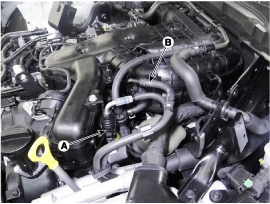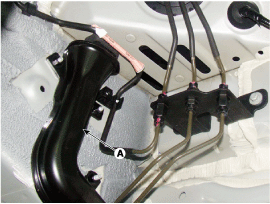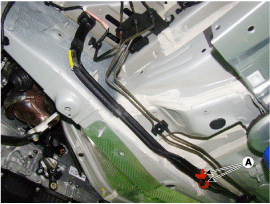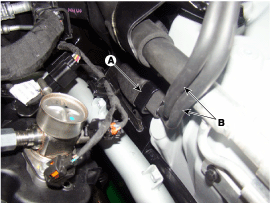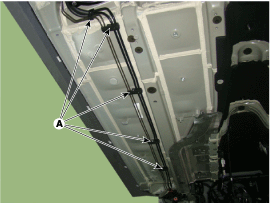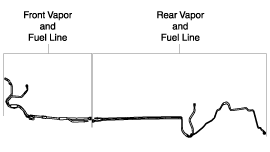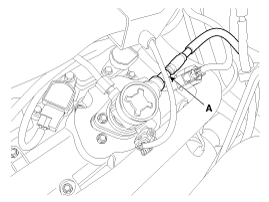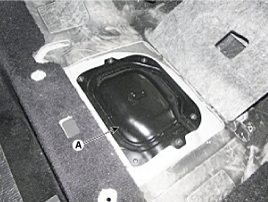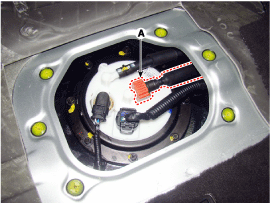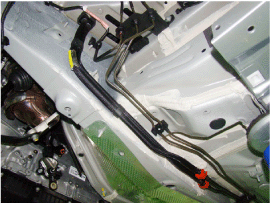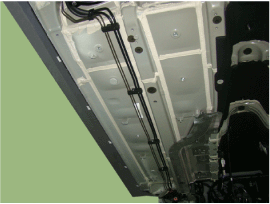Hyundai Genesis: Fuel Delivery System / Fuel Line Repair procedures
Hyundai Genesis (DH) 2013-2016 Service Manual / Engine Control / Fuel System / Fuel Delivery System / Fuel Line Repair procedures
| Removal |
| 1. |
Turn the ignition switch OFF and disconnect the negative (-) battery terminal. |
| 2. |
Release the residual pressure in fuel line.
(Refer to Fuel Delivery System - "Release Residual Pressure in Fuel Line") |
| 3. |
Disconnect the fuel feed tube quick-connector (A). |
| 4. |
Disconnect the vapor hose (B) which is connected to the PCSV.
|
| 5. |
Remove the front-LH wheel, tire and the inner wheel house. |
| 6. |
Remove the fuel line protector (A) after removing mounting nuts.
|
| 7. |
Disconnect the front vapor and fuel tube line quick-connector (A).
|
| 8. |
Remove the noise barrier (A) after loosening the mounting bolt and nut. |
| 9. |
Remove the front vapor and fuel tube line (B).
|
| 10. |
Remove the fuel tank.
(Refer to Fuel Delivery System - "Fuel Tank") |
| 11. |
Remove the vapor tube and fuel feed tube line fixing clips (A) by using a common driver.
|
| 12. |
Remove the fuel line from the bottom of the vehicle.
|
| Installation |
| 1. |
To install, reverse the removal procedure.
|
| Inspection |
| 1. |
Start the engine. |
| 2. |
Check the fuel feed line (A) installation state and fuel leakage state.
|
| 3. |
Fold the rear seat cushion. |
| 4. |
Remove the fuel pump service cover (A) after loosening the screws.
|
| 5. |
Check the fuel feed quick-connector (A) installation state and fuel leakage state.
|
| 6. |
Lift the vehicle. |
| 7. |
Check the fuel leakage state.
|
| 8. |
Replace the fuel line after checking the abnormal fuel line.
(Refer to Fuel Delivery System - "Fuel Line") |
 Fuel Pressure Sensor (FPS) Repair procedures
Fuel Pressure Sensor (FPS) Repair procedures
Inspection
1.
Connect the GDS on the Data Link Connector (DLC).
2.
Check the output voltage of fuel pressure sensor (FPS).
Specification: Refer to “Specification”
Removal
1.
Tu ...
 Filler-Neck Assembly Repair procedures
Filler-Neck Assembly Repair procedures
Removal
1.
Remove the filler neck mounting screws (A) after opening the fuel filler door.
2.
Remove the rear-left wheel & tire and wheel house cover.
3.
Disconnect the fuel filler hos ...
Other information:
Hyundai Genesis (DH) 2013-2016 Service Manual: Smart Key Repair procedures
Smart Key Smart Key Code Saving 1. Connect the DLC cable of GDS to the data link connector (16 pins) in driver side crash pad lower panel, turn the power on GDS. 2. Select the vehicle model and then do "Smart key code saving". 3. After selecting "Smart key teaching" menu, push "Enter" k ...
Hyundai Genesis (DH) 2013-2016 Service Manual: Front Seat Belt Retractor Repair procedures
Replacement • When installing or removing the belt, be careful not to damage the pretensioner. 1. Remove the front anchor seat belt (A). ? How to detach the anchor seat belt 1) Expose the red-colored indicator pin (A) by pushing the slot h ...
© 2013-2025 www.hgenesisdh.com

